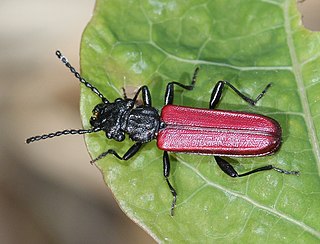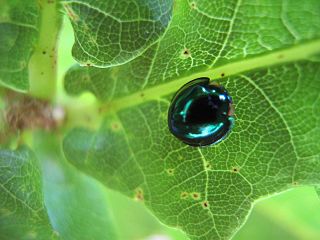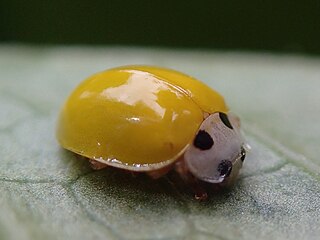
The Cucujidae, or flat bark beetles, are a family of distinctively flat beetles found worldwide under the bark of dead trees. The family has received considerable taxonomic attention in recent years and now consists of 70 species distributed in five genera. It was indicated Cucujus species are scavengers, only feeding on pupae and larvae of other insects and on other subcortical beetles such as their own. Since the Cucujidae prey on larvae of potentially tree damaging beetles that spread fungal diseases, they are considered to be beneficial to the health of living trees.

Scorpaena cardinalis, the eastern red scorpionfish, grandfather hapuku, cardinal scorpionfish, Cook's scorpionfish, Cook's rockcod, Kermadec scorpionfish, Northern scorpionfish, red scorpion fish, red scorpion-cod or Sandy-bay cod, is a species of marine ray-finned fish belonging to the family Scorpaenidae, the scorpionfishes. It is found in the southwestern Pacific Ocean.

Coccinella septempunctata, the seven-spot ladybird, is a carnivorous beetle native to the Old World and is the most common ladybird in Europe. The beetle is also found in North America, Central and Eastern Asia and regions with a temperate climate. Its elytra are of a red colour, but each punctuated with three black spots, with one further spot being spread over the junction of the two, making a total of seven spots, from which the species derives both its common and scientific names.

Hippodamia is a genus of ladybirds in the family Coccinellidae. It includes the most common native North American "ladybug", H. convergens, which can form overwintering aggregations numbering in the millions. Another notable member is Hippodamia variegata, which occurs widely over both the North and South Hemispheres.

Coccinellidae is a widespread family of small beetles. They are commonly known as ladybugs in North America and ladybirds in the United Kingdom; "lady" refers to mother Mary. Entomologists use the names ladybird beetles or lady beetles to avoid confusion with true bugs. The more than 6,000 described species have a global distribution and are found in a variety of habitats. They are oval beetles with a domed back and flat underside. Many of the species have conspicuous aposematic (warning) colours and patterns, such as red with black spots, that warn potential predators that they taste bad.

Halmus chalybeus, commonly known as the steelblue ladybird, is a species of ladybird native to Australia. It has a rounded appearance with an iridescent blue/green colouration and is a predator of other insects. It was introduced to New Zealand from Australia in 1899 and 1905 to control black scale and blue gum scale on citrus trees, where it is now common in northern regions. It has also been recorded eating San Jose scale. They are about 3–4 mm long.

Coccinella undecimpunctata, the eleven-spot ladybird or eleven-spotted lady beetle, it is native to central Asia, though commonly found in Europe, and formerly North America as its populations are decreasing. It is of the family Coccinellidae, commonly referred to as ladybugs or lady beetles.

Cryptolaemus montrouzieri, common name mealybug ladybird or mealybug destroyer, is a species of ladybird beetle native to eastern Australia. The beetle feeds on mealybugs and other scale insects, and is used to control those pests on citrus orchards worldwide.

Hoangus venustus, commonly known as the flax ladybird, is a species of ladybird beetle that is native to New Zealand, being found at least in the North Island. It can be found on New Zealand flax (Phormium) and Toetoe, reportedly eating the mealybugs that live there. Previously known as Cassiculus venustus, the valid name of the species is now Hoangus venustus.

Novius cardinalis is a species of ladybird beetle native to Australia. It was formerly placed in the genus Rodolia, but that genus was synonymized under the genus Novius in 2020.

Hippodamia variegata, the Adonis ladybird, also known as the variegated ladybug (US) and spotted amber ladybeetle (Aus), is a species of ladybeetle belonging to the family Coccinellidae, subfamily Coccinellinae.

Anatis ocellata, commonly known as the eyed ladybug, is a species of ladybug in the family Coccinellidae. It has black spots on a red background, with each spot surrounded by a yellowish halo. In one color variation, a specimen found in Scotland was reported having the spots fused to form longitudinal lines. Sometimes can also be found variation where black spots are absent.

Coccinellinae is a subfamily of lady beetles in the family Coccinellidae. There are at least 20 genera and 90 described species in Coccinellinae.

Novius is a genus of ladybird beetles belonging to the family Coccinellidae, and the sole member of the tribe Noviini. The genus as presently defined contains over 70 species, most of which were formerly placed in the genera Rodolia and Anovia, but after decades of debate, both of these genera are now considered to be junior synonyms of Novius.
Novius virginalis is a species of lady beetle in the family Coccinellidae, formerly placed in the genus Anovia.

Novius iceryae is a species of ladybird beetle native to Afrotropical realm, and was described from South Africa. It is also found in Senegal. In 1880, Novius iceryae was used to successfully control cottony cushion scale, Icerya purchasi in South Africa. It was later introduced in New Zealand for the management of cottony cushion scale. This and related species were formerly classified in the genus Rodolia.

Illeis is a genus of ladybird beetles in the family Coccinellidae. There are about five described species in Illeis, found in south and east Asia and in Oceania.
Novius breviuscula is a species of lady beetle native to India, Sri Lanka and Myanmar.
Novius octoguttata is a species of lady beetle native to India, Sri Lanka, Pakistan, Myanmar and China.

Parisopalpus nigronotatus, known by its common name, the spotted lax beetle, is a species of false blister beetles. It was first identified by Carl Henrik Boheman in 1858, under the name Nacerdes nigronotata. Native to eastern Australia, the species was introduced to New Zealand in 1931.
















